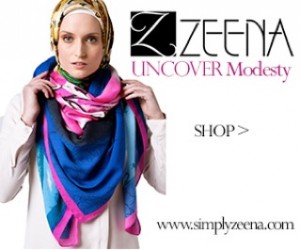

Source:
Bare Naked Islam. (2016). Zeena – Uncover modesty. Retrieved from
http://www.barenakedislam.com/2015/01/05/just-what-the-virginia-needs-baghead-f ashion-for-muslim-women/
Analysis of the Original Advertisement
This online advertisement is from Zeena, an American fashion brand that offers clothing and accessories to Muslim women. In this analysis, the problem of this advertisement is examined from the perspective of diction and the choice of model’s expression used by Zeena.
Firstly, from the perspective of diction, Zeena chooses to use the catch phrase “UNCOVER Modesty” to promote the value it provides for its customers when they choose to wear the clothing or accessories that the company offers. However, the problem with using the word “UNCOVER” is its insinuation that Muslim women are oppressed to wear the veil to cover themselves up. Thus, by choosing Zeena, they can break free to uncover themselves through Zeena’s fashion. The presentation of the word in capital letters also places emphasis on how Muslim women are in dire need of this value of freedom. In addition, Zeena also chooses the word “modesty” in its catch phrase to market how its products such as the advertised colourful veils can help accentuate the “modesty” of Muslim women derived from wearing the veil. This poses the problem of suggesting that the veil functions to highlight modesty for Muslim women. Secondly, Zeena chooses to portray the model as having a cheerless expression in this advertisement. This insinuates the representation of Muslim women’s typical attitude towards their veil code, and thus they should choose Zeena’s fashion to brighten up their appearance.
Therefore, the key problem with this advertisement is its marginalization of the veil and its overgeneralization of what the veil represents and means to Muslim women. As pointed out in Ahmed’s article “The Veil Debate – Again”, although Muslim women from places such as Saudi Arabia and Iran are legally obligated to wear the veil, it should not be considered as only a symbol of women oppression to modestly and cheerlessly cover themselves up (p. 248). This advertisement ignores how the veil can be a unique symbol of the wearer to express themselves.
Explanation of My Jamming Philosophy
In order to subvert the injurious social message of the advertisement, a jammed version is created by making two areas of changes, specifically in the diction of catch phrase and the choice of model’s expression used by Zeena.
Firstly, the catch phrase “UNCOVER Modesty” is changed to “DISCOVER Yourself”. The jamming philosophy for this change of diction is to remove false assumptions and overgeneralizations that the veil is a mere symbol of the oppression of Muslim women to modestly cover themselves up. This change serves to promote opening up possibilities for Muslim women to discover and express themselves through another outlet – fashion. As a result, this changed catch phrase communicates that the veil should be understood as a unique symbol of the wearer, representing what she stands for, such as her individual thoughts, feelings, beliefs and attitudes. By choosing Zeena’s products such as the advertised colourful veils, Muslim women can increase their level of self-expressions and have more choices to communicate their varying thoughts and beliefs. Presenting the word “DISCOVER” in capital letters changes emphasis to focus on promoting Muslim women’s sense of self-discovery and self-awareness in how the veil can be a dynamic symbol for them in different times or stages of their lives.
Secondly, by changing the model’s cheerless facial expression to a smile, it removes the false representation and overgeneralization of Muslim women’s unhappy attitude towards the veil code. Specifically, the smile aspires to invoke the promotion of self-confidence and positive attitude in how Muslim women see themselves in connection to wearing the veil. This smile also reveals the presentation of Muslim women’s beauty and how they can communicate such beauty through the fashion choices they make in veils. Overall, the jammed version promotes the respect of Muslim women in their choices of wearing the veil as a unique symbol of themselves.
References
Ahmed, L. (2005). The veil debate – again. In On Shifting Ground: Muslim Women in the
Global Era. New York, NY: The Feminist Press/CUNY.
Bare Naked Islam. (2016). Zeena – Uncover modesty. Retrieved from http://www.barenakedislam.com/2015/01/05/just-what-the-virginia-needs-baghead-f ashion-for-muslim-women/